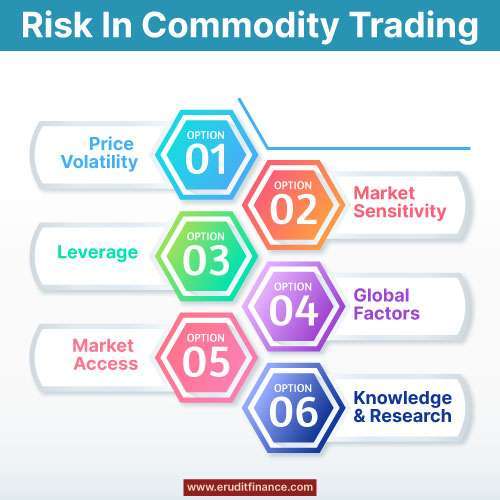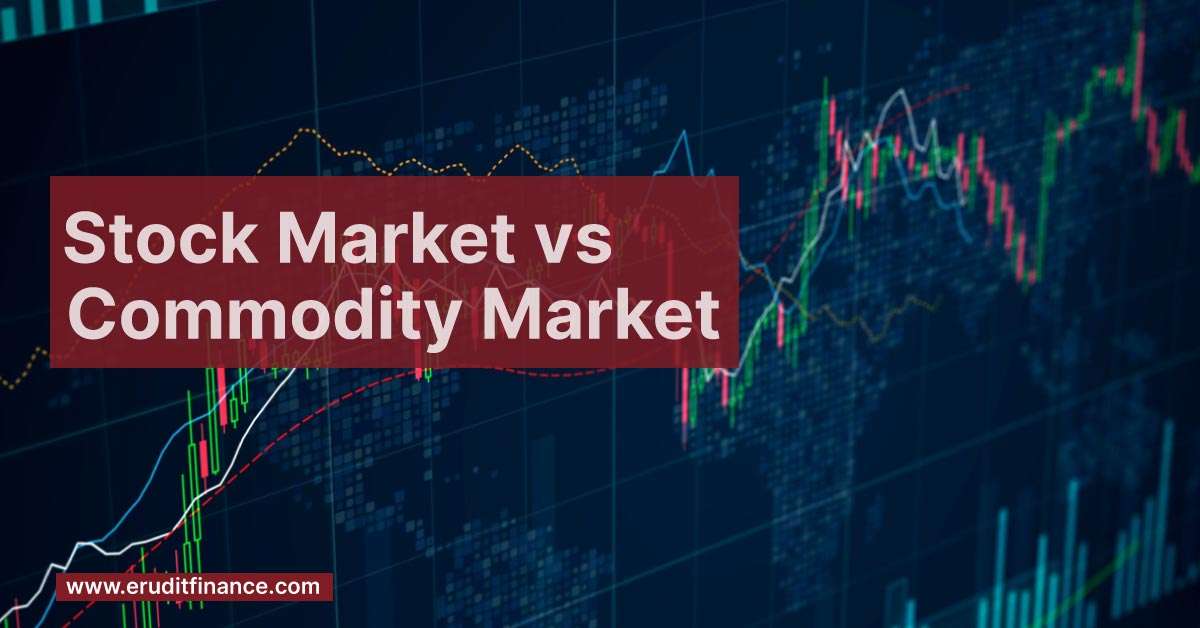The Difference Between Stock Market and Commodity Market are distinct in financial arenas. The stock market revolves around the buying and selling of shares in publicly traded companies, representing ownership in those enterprises. It serves as a barometer for economic health and corporate performance. In contrast, the commodity market deals with the trading of tangible goods such as agricultural products, metals, and energy resources. Investors in commodities aim to profit from price fluctuations, diversify portfolios, and manage risks. While both involve speculation, the stock market reflects corporate success, while the commodity market mirrors global supply and demand dynamics for physical goods. Understanding these differences is crucial for informed investment decisions.
Difference Between Stock Market and Commodity Market
| Stock Market | Commodity Market | |
| Nature of Assets | Involves the buying and selling of shares representing ownership in publicly traded companies. | Deals with tangible goods such as agricultural products, precious metals, energy resources, and industrial metals. |
| Asset Value | Stocks are financial instruments with value derived from the performance and profitability of the underlying companies | Commodities have intrinsic value based on their utility and scarcity in the physical world. |
| Purpose of Trading | Investors aim to benefit from the success and growth of the companies they invest in, receiving returns through dividends or capital appreciation. | Participants trade commodities to capitalize on price fluctuations influenced by global supply and demand, weather conditions, and geopolitical events. |
| Representation | Represents ownership and a stake in a company, giving investors certain voting rights and a share in the company’s profits. | Represents ownership of the actual physical goods, and prices are influenced by factors specific to each commodity. |
| Motivations for Investment: | Investors seek long-term growth, dividends, and a share in the success of the companies they invest in. | Investors often engage for portfolio diversification, risk management, and to capitalize on short to medium-term price movements. |
| Market Dynamics | Influenced by company-specific events, industry trends, economic conditions, and overall market sentiment. | Sensitive to factors such as global production levels, weather patterns, geopolitical tensions, and specific supply and demand dynamics for each commodity. |
| Volatility and Risk | Prices can be volatile based on company performance, market sentiment, and economic indicators. | Prices may experience volatility due to external factors like weather disasters, geopolitical crises, or sudden shifts in global supply and demand. |
| Mechanism of Investment | Investors buy and sell shares through stock exchanges, and ownership e is electronic and represented by shares. | Trading involves actual physical goods, and ownership may involve storage or delivery logistics. |
Understanding these key differences is crucial for investors, as it informs their strategies, risk management approaches, and overall decision-making in these diverse financial markets.
Is It Better To Trade Stocks or Commodities?
The decision between trading stocks or commodities depends on various factors, and what might be considered “better” varies based on individual preferences, risk tolerance, and investment goals. Here are some considerations for both options.
Trading Stocks
| Ownership and Dividends- Stocks represent ownership in companies, providing investors with a share of the company’s profits and potential dividends. |
| Long-Term Growth- Investing in stocks is often associated with long-term growth as successful companies tend to appreciate over time. |
| Market Information- Company-specific information, industry trends, and overall economic conditions influence stocks. |
| Diversification- The stock market offers a wide array of sectors and industries, providing opportunities for diversification. |
Trading Commodities
| Diversification and Risk Management- Commodities can be used to diversify a portfolio and manage risk, as they may not always move in sync with traditional financial assets like stocks. |
| Global Factors- Commodity prices are influenced by global supply and demand dynamics, geopolitical events, and weather conditions, offering a unique set of factors for analysis. |
| Short-Term Opportunities- Commodities often present short to medium-term trading opportunities, with prices reacting to immediate global events. |
| Intrinsic Value- Commodities have intrinsic value based on their physical nature and utility, potentially providing a hedge against inflation. |
Considerations for Both
| Risk Tolerance- Stocks and commodities can be volatile, and the choice depends on an individual’s risk tolerance and comfort level with market fluctuations. |
| Investment Horizon- Stocks are generally associated with long-term investing, while commodities might attract those seeking shorter-term opportunities. |
| Market Expertise- Success in either market often requires a good understanding of the specific market dynamics, regulations, and factors influencing prices. |
| Diversification Goals- Consideration of how each asset class fits into an overall investment strategy and goals for portfolio diversification. |
Ultimately, there is no one-size-fits-all answer, and a well-rounded investment strategy may involve a combination of both stocks and commodities.
What Is the Difference Between a Stock Exchange and a Commodity Exchange?
A stock exchange and a commodity exchange are both financial markets where various assets are traded, but they differ in the types of assets and financial instruments that are exchanged. Here are the key differences between a stock exchange and a commodity exchange.
| Stock Exchange | Commodity Exchange | |
| Types of Assets Traded | Deals with the buying and selling of financial instruments, primarily stocks or shares representing ownership in publicly traded companies. | Involves the trading of physical goods or commodities, such as agricultural products, metals, energy resources, and other tangible assets. |
| Nature of Instruments | Trades financial instruments like stocks, bonds, and other securities, representing ownership or debt in companies. | Trades physical commodities or commodity futures contracts, which are agreements to buy or sell a specified amount of a commodity at a predetermined future date and price. |
| Underlying Value | The value of stocks is derived from the performance and profitability of the underlying companies. | Commodity prices are influenced by factors such as global supply and demand dynamics, geopolitical events, and weather conditions. |
| Ownership and Dividends | Investors in stocks become partial owners of the companies, earning dividends and capital appreciation. | Trading commodities doesn’t involve ownership in a company; instead, investors seek to profit from price fluctuations. |
| Market Dynamics | Influenced by company-specific events, earnings reports, economic conditions, and overall market sentiment. | Sensitive to factors specific to each commodity, such as weather disasters, geopolitical crises, and changes in global supply and demand. |
| Market Participants | Participants include individual investors, institutional investors, and traders. | Involves a range of participants, including producers, consumers, speculators, and institutional investors. |
| Purpose for Participants | Investors seek long-term growth, income through dividends, and a share in the success of the companies they invest in. | Participants engage for various reasons, including portfolio diversification, risk management, and speculation on short to medium-term price movements. |
| Mechanism of Trading | Trades are executed electronically or on a physical trading floor through brokers and a centralized exchange. | Trades involve standardized contracts and are often facilitated through futures exchanges, where contracts are bought and sold based on the future delivery of commodities. |
Understanding these distinctions is crucial for investors and traders as they navigate the specific dynamics and characteristics of each exchange based on their investment goals and risk preferences.
What Is an Example of a Commodity Market?
In India, a prominent example of a commodity market is the Multi Commodity Exchange of India Ltd (MCX). MCX is a leading commodity futures exchange in the country, providing a platform for the trading of a variety of commodities.
MCX facilitates the trading of commodities such as precious metals (gold and silver), base metals (copper, zinc, and aluminum), energy resources (crude oil and natural gas), agricultural products (soybean, crude palm oil, and cotton), and various other commodities.
Similar to other commodity exchanges globally, MCX enables market participants, including farmers, producers, traders, and investors, to engage in futures contracts for price discovery, hedging, and speculation. The exchange plays a significant role in India’s commodities market, contributing to the efficient functioning and liquidity of the country’s commodity trading ecosystem.
How Risky Is Commodity Trading?
Commodity trading carries a level of risk that investors should carefully consider before participating. The degree of risk can vary based on several factors, and understanding these aspects is crucial for effective risk management. Here are some key factors contributing to the riskiness of commodity trading.

a). Price Volatility- Commodities are often subject to significant price volatility due to global supply and demand dynamics, geopolitical events, weather conditions, and economic indicators. Rapid price fluctuations can lead to both substantial gains and losses.
b). Market Sensitivity- Commodity prices can be highly sensitive to external factors beyond traditional financial markets, including natural disasters, political instability, and changes in global production levels. These factors make commodity markets responsive to unpredictable events.
c). Leverage- Trading on margin, or using leverage, is common in commodity markets. While leverage can amplify profits, it also magnifies potential losses. Traders can end up owing more than their initial investment, leading to significant financial risk.
d). Global Factors- Commodities are influenced by global events and conditions. Economic developments, trade policies, and geopolitical tensions can impact commodity prices, making them susceptible to factors beyond a trader’s control.
e). Supply and Demand Dynamics- The inherent nature of commodities, with physical goods having tangible supply and demand factors, can introduce uncertainties. Changes in production levels, unexpected demand fluctuations, or disruptions in the supply chain can impact prices.
f). Market Access- Access to commodity markets often involves futures contracts, which come with their own set of risks. Traders need to be aware of contract specifications, expiration dates, and the potential for delivery obligations if holding contracts until maturity.
g). Diversification Challenges- While commodities offer diversification benefits, they may not always move in the opposite direction to traditional financial assets like stocks and bonds. Correlation patterns can change, impacting the effectiveness of diversification as a risk mitigation strategy.
h). Knowledge and Research- Successful commodity trading requires a deep understanding of the specific commodities being traded, as well as the global factors influencing their prices. Lack of knowledge and thorough research can increase the risk of making uninformed decisions.
Individuals involved in commodity trading need to assess their risk tolerance, develop a well-thought-out strategy, and employ risk management tools such as stop-loss orders. Additionally, staying informed about market trends, global events, and economic indicators can help traders make more informed decisions, mitigating some of the inherent risks associated with commodity trading.
What Is Derivative in Trading?

In trading, a derivative is a financial instrument whose value is derived from the value of an underlying asset, index, rate, or other reference point. Derivatives allow investors and traders to speculate on price movements, hedge against risks, and gain exposure to various financial markets without owning the underlying asset.
There are various types of derivatives, with the most common ones being.
| Futures Contracts | These are agreements between two parties to buy or sell an asset at a specified future date for a price agreed upon today. Futures contracts are often used for hedging and speculation |
| Options Contracts | Options give the holder the right, but not the obligation, to buy (call option) or sell (put option) an asset at a predetermined price within a specified time frame. Options are commonly used for hedging and risk management. |
| Swaps | Swaps involve the exchange of cash flows or other financial instruments between two parties. Common types include interest rate swaps and currency swaps, used for managing interest rate and currency risks. |
| Forwards Contracts | Similar to futures contracts, forwards are agreements to buy or sell an asset at a future date for a predetermined price. However, forwards are typically traded over-the-counter (OTC) and are customizable. |
What Is the Most Traded Commodity in the World?
The most traded commodity in the world is Crude Oil. Crude oil is a vital energy source and a key raw material for numerous industries, making it the primary commodity in global trade. The demand for crude oil is driven by its use in the production of various fuels, including gasoline, diesel, and jet fuel, as well as in the manufacturing of a wide range of products such as plastics, chemicals, and lubricants.
What Is the Difference Between Commodities and MCX?
Commodities and MCX (Multi Commodity Exchange of India Ltd) refer to different aspects within the context of financial markets.
| Definition | Market Context | |
| Commodities | Commodities are physical goods or raw materials that are interchangeable with other goods of the same type. They can be broadly categorized into agricultural products (e.g., wheat, corn), precious metals (e.g., gold, silver), energy resources (e.g., crude oil, natural gas), and industrial metals (e.g., copper, aluminum). | “Commodities” generally refers to the class of tangible assets that are traded on commodity exchanges. These assets have intrinsic value based on their utility and scarcity. |
| MCX | MCX is a specific commodity exchange based in India. It is one of the leading commodity futures exchanges in the country, providing a platform for the trading of various commodities through futures contracts. | When people refer to MCX, they are specifically talking about the exchange itself, where commodities such as precious metals, energy resources, agricultural products, and base metals are actively traded. |
In summary, “commodities” is a broad term encompassing a wide range of tangible goods traded globally, while “MCX” specifically refers to commodity exchange in India where various commodities are actively traded through futures contracts. MCX is an example of an exchange where commodities are bought and sold, and it operates within the broader context of the commodities market.
Bottomline:-
The stock market deals with the buying and selling of shares representing ownership in companies, reflecting corporate performance and economic health. In contrast, the commodity market involves trading tangible goods like agricultural products and precious metals, driven by global supply and demand dynamics. While the stock market focuses on company success, dividends, and capital appreciation, the commodity market revolves around the intrinsic value of physical goods and the factors influencing their prices, offering investors diverse avenues for participation and risk management in the financial landscape.
Also Read:










